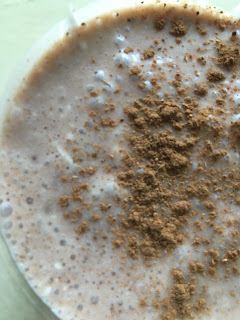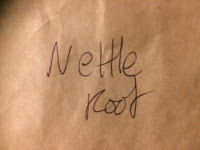 Kefir is all the rage at the moment - suddenly supermarkets are stocking it with Yeo Valley and other brands. I'm guessing readers will have come across it - a fermented beverage that is full of probiotics and beneficial enzymes - indeed it has as many as 30 strains of good bacteria. It is made using kefir grains (nothing to do with actual grains) to ferment milk, making it into a liquidy yogurt drink.
Kefir is all the rage at the moment - suddenly supermarkets are stocking it with Yeo Valley and other brands. I'm guessing readers will have come across it - a fermented beverage that is full of probiotics and beneficial enzymes - indeed it has as many as 30 strains of good bacteria. It is made using kefir grains (nothing to do with actual grains) to ferment milk, making it into a liquidy yogurt drink.
Allegedly kefir recipes in some parts of the world were closely guarded secrets for generations and passed on as part of a woman’s dowry. Marco Polo wrote about this drink and there are tales that the prophet Muhammad brought the grains to mountain tribes; some have even called them “grains of the Prophet”. They also get a mention in the Old Testament as the “manna” that fed the Israelites in the desert for so many years. “Kef” means to “feel good” in Turkish and certainly it has been shown to have a host of health benefits like tackling asthma but also possibly protecting against some cancers. More on health benefits can be found below.
Mass production of kefir didn’t begin until the mid 1900s in Russia. While it may not have been much in the UK, I know that in Norway, where my partner is from, it has been available for as long as her mum can remember. It was one of my go-tos in Norwegian supermarkets - they have some wonderful different brands with added blueberries and more. I have also made milk kefir in the past - It is worth noting that the fermentation process removes most of the lactose (milk sugar) so this is different from many other dairy products. However for vegans and some folks who want to avoid dairy, there is the option of coconut kefir. It seemed fun to explore the possibilities of this.....but before I get to that....
Water Kefir?
It is worth mentioning water kefir - both milk and water kefir varieties are rich in beneficial bacteria. However, as always, we should not get swept up in the idea that they are good for everyone - the advice is to check with your doctor before drinking - especially if you have any condition that weakens your immune system or for example are having chemo. Other folk I’ve heard that should check out or avoid are people with mastocytosis, are histamine intolerant, taking monoamine oxidase inhibitors (anti-depressants), those who regularly get migraine headaches and those with bowel problems or if colon cancer runs in your family.
So you can make kefir from water and sugar - these are different grains from the milk - and some have said it is similar to Kombucha - but Kombucha has a tart zing, while water kefir is sweeter in flavour. However many of us with cancer are trying to avoid sugar - for me I feel happier with the coconut kefir but it is argued by some who make the water kefir, that you can reduce the sugar content. This is done by allowing your water kefir to ferment until it is just a little bit sweet on the first fermentation (i). Then when it is bottled, there will be enough sugar, with the addition of fruit or fruit juice, for carbonation, but will have a lower sugar content once the second fermentation is complete (ii). Apparently using water kefir grains to culture coconut water also produces less sugar but this can’t be done all the time as it wears the grains out.
Coconut Milk Kefir
There are lots of recipes on the web but this one below is one where we have used milk kefir grains to ferment the coconut milk. Coconut milk kefir is milder and less-tangy taste than traditional milk kefir - which for me is a bit disappointing as I like the tangy! Coconut milk has no lactose but does seem to need more help to keep going than the dairy milk kefir. However check your coconut milk as so many come with other ingredients - you want something that is 75% or more coconut milk and no other ingredients!
Coconut milk is made by grating and squeezing the flesh of coconuts. This is then filtered and diluted with water. We should remember that coconut milk is high in a type of saturated fat called medium-chain fatty acids - this is processed differently than the saturated fat from animal products. It is said that this fat will be absorbed more quickly by your body rather than being stored in adipose tissue for later use. Certainly there is a big debate regarding coconut oil; is it good or bad for someone with cancer (iii) - but that is oil rather than milk. On balance I think coconut is better than dairy for me so here are the details on how to make it...
The recipe
2-4 tablespoons of milk kefir grains (in Stroud they are often given away by folks but you can also purshase online)
800ml of coconut milk (available in cans or cartons)
Instructions (iv)
- Add the milk kefir grains to the coconut milk in a large glass jar (we use a storage jar)
- Cover lightly with a tea towel and leave at room temperature for at least 12 hours; one comment was to put it in the fridge as it generally 'goes' really quickly. Temperature should be 4° or above. We haven't used the fridge.
- After 12 hours you can start tasting the kefir until it reaches desired level of fermentation or ‘tanginess’. A stir can be helpful if it is in for longer than 24 hours - it can get quite thick! We usually have ours at 48 hours but it depends very much on many factors; temperature, quantities of grains etc
- Strain out the milk kefir grains; we use a plastic sieve - this is not too hard but needs to be done with care so as not to damage the grains. Apparently metal can disrupt the fermentation process so use plastic or other implements.
- Add new coconut milk to repeat the process - don’t rinse your grains.
- Store the kefir in the fridge until you use it

Revive your grains
Using non-dairy leads to the grains withering and even dying over time; they need that lactose to help them thrive. Our grains have been used for quite a number of batches and they have lost their cauliflower shape and are more soft and mushy. They are ready for a revive!
One technique I have read about and am set to try in this coming week, is putting the grains in a bowl covered with milk - some recipes suggest to add one teaspoon of sugar. You then have to replace the milk every 48-72 hours. After a number of times the milk will begin to separate into a clear liquid at the bottom - that’s the whey. When there are signs of fermentation again it is time to start a new batch. One suggestion was to then start with one tablespoon of grains to every two cups of milk. It can apparently take some weeks to get back to full strength.
Resting your grains
We’ve taken a break several times from kefir - basically you can rest the grains in the fridge, but the longer you rest the grains, the longer it will take to revive them. The grains also don’t have the same bacteria diversity present in fresh grains - this will come back in time. We’ve used the freezer to rest our grains just as they are - we didn’t dehydrate first as suggested below and they seem to have recovered alright.
I’ve seen this suggestion:
1-7 days: Place the grains in a glass jar and fill with fresh milk. Store in the fridge.
7-14 days: Place the grains in a glass jar and leave them dry (with no liquid). Store in the fridge.
14+ days: Lay grains out on a dehydrator sheet and dehydrate them at 36°C – 40°C until dry. Store the dehydrated grains in a freezer safe bag in the freezer.
7-14 days: Place the grains in a glass jar and leave them dry (with no liquid). Store in the fridge.
14+ days: Lay grains out on a dehydrator sheet and dehydrate them at 36°C – 40°C until dry. Store the dehydrated grains in a freezer safe bag in the freezer.
 |
| See recipe below! |
Health Benefits
Dr Axe lists many of the possible key benefits of kefir (vi); three key ones, that are important to those of us with cancer, are worth noting here:
1. Support to the Immune. One of the bacterias is specific to kefir alone ie Lactobacillus kefiri, and has been shown to help defend against harmful bacteria like salmonella and E. coli. The bacterias in the kefir help modulate the immune system and inhibit many predatory bacteria growth. Kefir also has an insoluble polysaccharide called kefiran, which a 2005 study found is antimicrobial and helps tackle candida symptoms and speed healing of external wounds.
2. Helps digestion. We know how absolutely essential a good microbiome is for health - and key in cancer. The probiotics (vii) in the coconut kefir are great at discouraging constipation, supporting good elimination, reducing side-effects of antibiotics and they will tackle pathogens.
3. Tackles cancer. Most cancer studies are with dairy kefir, but it seems the positive outcomes are very likely to be transferable to coconut kefir. One dairy-based kefir study showed that kefir can slow the growth of early tumors and their enzymatic conversions from non-carcinogenic to carcinogenic (viii). Meanwhile an in-vitro test in Canada showed that kefir reduced breast cancer cells by 56 percent (as opposed to yogurt strains that reduced cells by 14 percent) (ix).
Update 4/06/20: new research with mice shows positive impact on immune system: https://apc.ucc.ie/dont-cry-over-fermented-milk/
Update 4/06/20: new research with mice shows positive impact on immune system: https://apc.ucc.ie/dont-cry-over-fermented-milk/
 |
| See recipe left |
Today I’m enjoying an Iced Cacoa Coconut Kefir - basically coconut kefir, a couple of ice cubes, a dessertspoon of cacoa and one of chia seeds with a sprinkle of cinnamon - allow to sit for 10 mins or so - yum! But also love a great dollop on quinoa porridge. It is a rather wonderful treat.
I still feel like I am learning with this coconut kefir, so I'd love to hear from other kefir-makers and welcome any tips, suggestions, corrections, thoughts and more.
Notes
(i) https://www.culturesforhealth.com/learn/water-kefir/how-to-make-water-kefir/
(ii) https://www.culturesforhealth.com/learn/water-kefir/bottling-water-kefir/
(iii) https://www.canceractive.com/article/Coconut-oil-vs-Extra-Virgin-Olive-Oil-(EVOO)
(i) https://www.culturesforhealth.com/learn/water-kefir/how-to-make-water-kefir/
(ii) https://www.culturesforhealth.com/learn/water-kefir/bottling-water-kefir/
(iii) https://www.canceractive.com/article/Coconut-oil-vs-Extra-Virgin-Olive-Oil-(EVOO)
(iv) There are many online 'recipes' you can follow like: https://wellnessmama.com/54711/coconut-milk-kefir-recipe/ and lots of questions answered here:




















